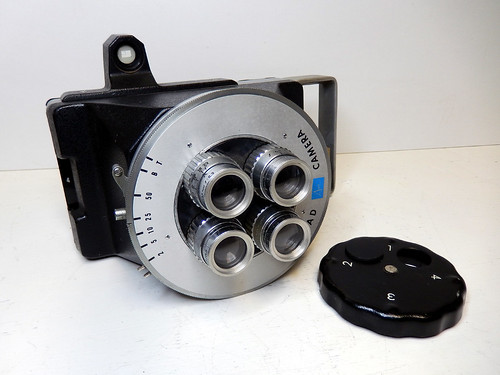Difference between revisions of "Quad Camera"
(gearwheel) |
m (image link repair) |
||
| Line 1: | Line 1: | ||
{{flickr_image | {{flickr_image | ||
|image_source= https://www.flickr.com/photos/132420193@N06/22617290002/in/pool-camerawiki | |image_source= https://www.flickr.com/photos/132420193@N06/22617290002/in/pool-camerawiki | ||
| − | |image= https://live.staticflickr.com/ | + | |image= https://live.staticflickr.com/65535/22617290002_5bb031df44_m_d.jpg |
|image_align= right | |image_align= right | ||
|image_text= The Quad Camera (Model 32-100 Bs) | |image_text= The Quad Camera (Model 32-100 Bs) | ||
Revision as of 07:22, 9 July 2021

|
| The Quad Camera (Model 32-100 Bs) image by Luis Cozeto (Image rights) |
The Quad Camera was invented as passport photo shooter for the U.S. Government by Avant's engineer Samuel Kitrosser - in 1964 he was mentioned as inventor in U.S. Patent No. USD201225. It is a Disderi type large format camera for shooting passport photos onto sheet film. Disderi type means that its camera chamber is divided into compartments, each over a part of the film sheet and each equipped with an own camera lens. Thus four images can be shot at once onto one film sheet. The aperture-setting rings of the four lenses are simply coupled by a single gearwheel inbetween. A special lens cap allows to shot just one or two images at once instead. The camera has one big leaf shutter - each of its four leaves opens behind one of the four lenses. Thus exposure time range is limited down to 1/50 seconds. The camera has four equal Elgeet 90mm f:6.3 Anastigmat lenses, contacts for attaching a flash gun, an optical viewfinder, and a sheet film holder for Polaroid instant sheet film cartridges (Polaroid film Type 100, 8.5%times;10.5cm). An alternate version was equipped with Ilex Paragon 90mm f6.4 lenses. Some cameras have one little lens cap for each lens instead of the special one for all.
With a weight of 2250g the camera was quite heavy.
Avant also held a patent for a ring flash gun for that camera.
The successor camera, constructed by engineer Kitrosser in 1969, had an inbuilt four-image frame to assure that images with white borders were achieved. He also invented a variant with two different compartment sizes, for achieving two images of each frame size at once on the film sheet.

|
| The Quad Camera (Model 32-100 Bs) image by Luis Cozeto (Image rights) |

|
| The Quad Camera (Model 32-100 Bs) with the special lens hood image by Mark Dalzell (Image rights) |
Links
- Quad Camera at collection-appareils.fr [1]
- further facts in German at kamerasammlung.ch [2]